#Bidirectional ESD Protection
Explore tagged Tumblr posts
Text
https://www.futureelectronics.com/p/electromechanical--circuit-protection--tvs-diodes/usblc6-2sc6y-stmicroelectronics-1103009
Bidirectional ESD Protection, diode circuit, Low Capacitance TVS Diode Array
USBLC6 Series 2 Line 6 V Uni / Bi Directional ESD Protection - SOT-23-6
#Circuit Protection Devices#TVS Diodes#USBLC6-2SC6Y#STMicroelectronics#Transient Voltage Suppressor diode#High-voltage transients#circuit#Bidirectional ESD Protection#diode circuit#Low Capacitance Array#application#suppression diode
1 note
·
View note
Text
https://www.futureelectronics.com/p/electromechanical--circuit-protection--esd-protection/pgb1010603nr-littelfuse-4017083
Electrostatic discharge protection, diode arrays, Arrays Electrostatic induction
PGB1 Series 150 V 0.06 pF Bi-Directional 0402 SMT PulseGuard® ESD Suppressor
#Circuit Protection#ESD Protection & Diode Arrays#PGB1010603NR#Littelfuse#Electrostatic discharge protection#Arrays Electrostatic induction#Bidirectional#protection arrays#ESD protection equipment#USB ESD protection#ESD protection circuit
1 note
·
View note
Text
https://www.futureelectronics.com/p/electromechanical--circuit-protection--esd-protection/pgb1010603nr-littelfuse-3173322
Diode array manufacturers, USB ESD protection, ESD protection circuit,
PGB1 Series 150 V 0.06 pF Bi-Directional 0402 SMT PulseGuard® ESD Suppressor
#Littelfuse#PGB1010603NR#Circuit Protection#ESD Protection & Diode Arrays#manufacturers#USB ESD protection#ESD protection circuit#Bidirectional ESD protection diode#Diode Array devices#What is Circuit Protection#ESD protection equipment
1 note
·
View note
Text
https://www.futureelectronics.com/p/electromechanical--circuit-protection--esd-protection/esdalc6v1p6-stmicroelectronics-2113252
STMicroelectronics, ESDALC6V1P6, ESD Protection & Diode Arrays
ESDALC Series 4 Channel 6.1V Uni-Directional Transil™ ESD Protection - SOT-666IP
#STMicroelectronics#ESDALC6V1P6#ESD Protection & Diode Arrays#equipment#ESD tools#Bidirectional ESD#Electrostatic discharge protection#ESD suppressor diode#usb ESD protection#what is ESD protection#Diode Array devices
1 note
·
View note
Text
https://www.futureelectronics.com/p/electromechanical--circuit-protection--tvs-diodes/sm712-tct-semtech-1709229
Asymmetrical TVS Diode, USB TVS diode array, TVS diode circuit, esd tools
SM Series 12 V 400 W Asymmetrical TVS Diode for Extended Common-Mode - SOT-23
#Semtech#SM712.TCT#Circuit Protection Devices#TVS Diodes#capacitance#Bidirectional TVS diode application#Asymmetrical TVS Diode#USB TVS diode array#TVS diode circuit#esd tools#Transient voltage suppressors#TVS Diode manufacturers
1 note
·
View note
Text
How to Choose the Right Device for NFC Interface Protection?
Applications
In the era of the Internet of Things, especially with the ongoing spread of Omicron, many of our products now use near-field communication (NFC) or other wireless methods for communication. All wireless products are equipped with antennas, and how to implement interface protection in small-sized products has troubled many engineers.
Selection Criteria
First, to meet the requirements of such electronic products — thin, small, and portable — the ESD protection component must be sufficiently compact. For example, a 0402 package, or even a 0201 package, can achieve the advantages of high integration and high flexibility in PCB design.
Second, the parasitic capacitance of the ESD protection component’s pins must be small to avoid signal interference. For instance, when using an ESD protection component in an antenna, the frequency band of the antenna and the minimum acceptable parasitic capacitance for different frequency bands must be considered. Typically, the parasitic capacitance of ESD protection components used in antennas should be less than 1pF, or even lower.
Third, when selecting the maximum operating voltage and unidirectional/bidirectional characteristics of ESD protection components, the highest and lowest voltages of the signal swing must be considered to prevent signal interference. For example, in an NFC antenna, the maximum signal voltage typically reaches 18V, and negative voltages may also occur, so a bidirectional ESD protection component suitable for this signal voltage range must be selected. In a GPS antenna, the maximum voltage is usually less than 5V and the minimum voltage is no less than 0V, so a 5V unidirectional ESD protection component can be used.
Fourth, the ESD protection component must have high tolerance to ESD events, at least capable of withstanding 8kV ESD attacks in contact mode as per IEC 61000–4–2.
Fifth, and most importantly, the clamping voltage of the ESD protection component during an ESD event must be low enough. This not only protects the circuit from permanent damage caused by electrostatic discharge but also ensures that signal transmission is not interfered with by the ESD.
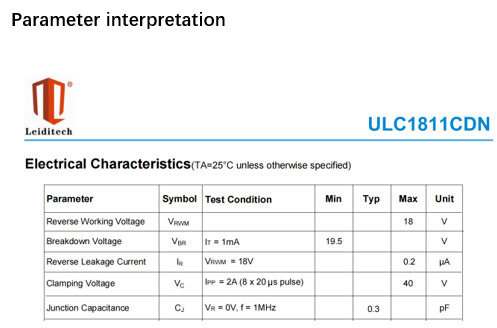
Leiditech Electronics is committed to becoming a leading brand in electromagnetic compatibility (EMC) solutions and component supply. We offer a wide range of products, including ESD, TVS, TSS, GDT, MOV, MOSFET, Zener diodes, and inductors. With an experienced R&D team, we provide personalized customization services to deliver the highest quality EMC solutions tailored to our customers’ needs.
If you’d like to learn more or have any questions, don’t hesitate to reach out:
Visit us at [en.leiditech.com]
#ESDProtection #NFC #IoTDevices #WirelessTech #EMCsolutions #PCBDesign #ElectronicsEngineering #Leiditech #TechInnovation #ClampingVoltage #ElectrostaticProtection #TechTips #CircuitProtection
0 notes
Text
#ROHM#nextgen#autonomous#AutonomousVehicles#CANFD#TVSDiodes#AutomotiveElectronics#Innovation#electronicsnews#technologynews
0 notes
Text
Understanding the Technical Specifications of SMBJ70CA-TR TVS Diodes
TVS (Transient Voltage Suppression) diodes, such as the SMBJ70CA-TR, play a crucial role in protecting electronic circuits from voltage spikes and electrostatic discharge (ESD). Understanding their technical specifications is essential for selecting the right component for your application. Let's dive into the key specifications of the SMBJ70CA-TR TVS diode and what they mean for your projects.

1. Breakdown Voltage (V_BR)
The breakdown voltage is the voltage at which the diode starts to conduct in reverse. For the SMBJ70CA-TR, the breakdown voltage range is typically between 77.8V and 95.7V. This means that when the voltage exceeds this range, the diode will begin to conduct, clamping the voltage to a safe level and protecting the circuit.
2. Stand-off Voltage (V_R)
The stand-off voltage is the maximum voltage that can be applied to the diode without it conducting. For the SMBJ70CA-TR, the stand-off voltage is 70V. This is the normal operating voltage below which the diode remains inactive. It’s crucial to ensure that the operating voltage of your circuit does not exceed this value.
3. Peak Pulse Current (I_PP)
The peak pulse current is the maximum current the diode can handle during a transient event. The SMBJ70CA-TR can withstand a peak pulse current of 1.3A (10/1000µs waveform). This parameter is vital for understanding the diode’s capacity to handle sudden surges and is a key factor in ensuring the protection of your circuit.
4. Clamping Voltage (V_C)
The clamping voltage is the voltage to which the diode clamps the transient event. For the SMBJ70CA-TR, the clamping voltage is 113V at a peak pulse current of 1.3A. This value indicates the maximum voltage your circuit will experience during a transient event, ensuring it remains within safe limits.
5. Power Dissipation (P_PP)
Power dissipation is the maximum power the diode can dissipate. The SMBJ70CA-TR has a peak pulse power dissipation of 600W (10/1000µs waveform). This parameter helps determine the diode’s ability to handle power surges without being damaged.
6. Response Time
The response time of a TVS diode is the time it takes to respond to a transient event. The SMBJ70CA-TR has a response time of less than 1 picosecond. This ultra-fast response ensures immediate protection for sensitive electronic components from voltage spikes.
7. Capacitance
The capacitance of a TVS diode affects the signal integrity in high-speed circuits. For the SMBJ70CA-TR, the capacitance is typically 150pF at 1MHz. Lower capacitance is preferred for high-frequency applications to avoid signal degradation.
8. Packaging
The SMBJ70CA-TR is packaged in an SMB (DO-214AA) package. This surface-mount package is suitable for automated assembly processes and offers a compact form factor for space-constrained applications.
9. Polarity
The SMBJ70CA-TR is a bidirectional TVS diode. This means it can protect against both positive and negative voltage transients, making it versatile for various applications where bidirectional protection is required.
10. Operating and Storage Temperature Range
The operating temperature range for the SMBJ70CA-TR is from -55°C to +150°C, and the storage temperature range is also -55°C to +150°C. This wide temperature range ensures reliable performance in diverse environmental conditions.
11. Qualification and Compliance
The SMBJ70CA-TR TVS diode complies with industry standards and qualifications, ensuring high reliability and performance. It meets the requirements of IEC 61000-4-2 (ESD) and IEC 61000-4-4 (EFT) standards, making it suitable for robust ESD and surge protection.
Conclusion
Understanding the technical specifications of the SMBJ70CA-TR TVS diode is crucial for ensuring the protection and reliability of your electronic circuits. By carefully considering parameters such as breakdown voltage, stand-off voltage, peak pulse current, clamping voltage, power dissipation, and response time, you can select the right TVS diode for your application. Additionally, factors like capacitance, packaging, polarity, and temperature range are important to ensure optimal performance and compatibility with your design requirements.
0 notes
Text
https://www.futureelectronics.com/p/electromechanical--circuit-protection--tvs-diodes/pesd1can-215-nexperia-6297154
USB Zener diode, Transient voltage suppression, Bidirectional TVS diode
PESD1CAN Series 70 V 17 pF SMT CAN Bus ESD Protection Diode - SOT-23
#Circuit Protection Devices#TVS Diodes#PESD1CAN#215#Nexperia#USB Zener diode#Transient voltage suppression#Bidirectional TVS diode#surge suppressor#LDO Voltage Regulator#Zener diode#application#TVS diode#transient voltage suppression diode
1 note
·
View note
Text
ESD protection diode circuit
Next year, I will concentrate on learning about; ESD protection diode circuit, Protection diode bidirectional and Littelfuse, PGB1010603NR, Circuit Protection, ESD Protection & Diode Arrays.
0 notes
Text
High-Speed Signal Dual-Channel SOT-23 Low Capacitance ESD Protection
Shanghai Leiditech often receives inquiries from new and existing customers: “Do you have dual-channel bidirectional 3.3V or 5V… ESD diodes for high-speed signals? We need to protect two I/O ports from ESD, preferably in SOT-23 package.”
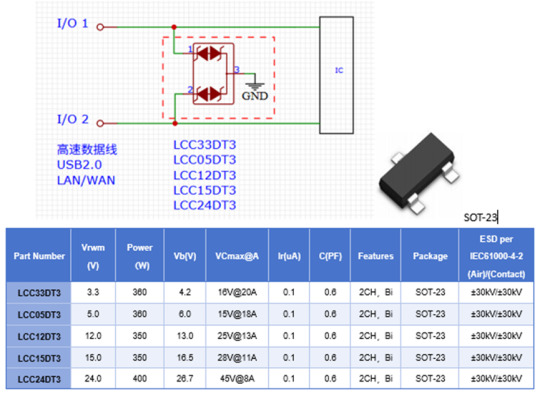
l The LCC33DT3, LCC05DT3, LCC12DT3, LCC15DT3, and LCC24DT3 series can meet customers’ ESD protection requirements for 3.3V, 5V, 12V, 15V, and 24V signal voltages, which are the conventional signal voltages required by customers.
l Dual-channel bidirectional ESD protection: One device is sufficient to meet the requirement, saving space and facilitating PCB layout.
l Complies with IEC61000–4–2 (ESD) with ±30kV (air) and ±30kV (contact), meeting ESD Level 4 (±8kV/15kV) protection.
l All models in this series have a peak power of over 300W, featuring not only high ESD protection but also strong surge resistance to protect against surges caused by hot-swapping.
l Low clamping voltage (VCmax@A) under peak current conditions.
l Low junction capacitance (approximately 0.6pF), suitable for high-speed signal applications.
l Low leakage current (0.1μA).
For high-speed dual-channel ESD protection and other interface ESD/surge protection requirements, please contact Leiditech’s sales team or the EMC specialist.
Leiditech Electronics is committed to becoming a leading brand in electromagnetic compatibility (EMC) solutions and component supply. We offer a wide range of products, including ESD, TVS, TSS, GDT, MOV, MOSFET, Zener diodes, and inductors. With an experienced R&D team, we provide personalized customization services to deliver the highest quality EMC solutions tailored to our customers’ needs.
If you’d like to learn more or have any questions, don’t hesitate to reach out:
Visit us at [en.leiditech.com]
#ESDProtection #HighSpeedDesign #PCBDesign #USB3 #HDMI #LAN #IoTDesign #EMCsolutions #SOT23 #TVSdiode #ElectronicsDesign #SurgeProtection #Leiditech #SignalIntegrity #ESDdiodes
0 notes
Text
#Vishay Intertechnology#automotive#networks#electrostaticdischarge#space#electronicsnews#technologynews
0 notes
Text
Diodes Incorporated Introduces Space-Saving TVS with Superior ESD and Surge Protection for High-Speed I/O

【Lansheng Technology Information】On April 6, 2023, Diodes announced the launch of a new bidirectional transient voltage suppressor diode (TVS) to meet the market's demand for robust protection of high-speed data ports. The D3V3Z1BD2CSP is designed to meet protection against electrostatic discharge (ESD) shock and surge events. Primary applications for this product are high-performance computing hardware, I/O ports for smartphones, laptops and tablets, monitors, and game consoles.
While many competing products have to make a design compromise between strong surge protection features or low input capacitance, the D3V3Z1BD2CSP can provide both. Its extremely low capacitance value (0.3pF typical) does not interfere or prevent high-speed data communications, thus ensuring that signal integrity is maintained. Its high peak pulse current (10.5A typical) and low clamping voltage (5.3V) protect I/O ports and their sensitive electronic components from transient voltages. The risk of electrical overload damage caused by activities such as frequent hot swapping is thus avoided. The D3V3Z1BD2CSP complies with the IEC61000-4-2 immunity standard and provides robust ESD protection against ±20kV air and contact discharge, thereby increasing system reliability.
The D3V3Z1BD2CSP can be used to protect I/O interfaces such as USB Type-C®, DisplayPort™, HDMI™, and SD cards, carrying high-speed data transfer rates up to 20Gbps. The -55°C to +150°C operating temperature range ensures continuous protection in challenging product application environments.
Diodes' D3V3Z1BD2CSP TVS is packaged in an extremely compact DSN0603 wafer-level chip size package measuring only 0.6mm x 0.3mm x 0.3mm.
Lansheng Technology Limited, which is a spot stock distributor of many well-known brands, we have price advantage of the first-hand spot channel, and have technical supports.
Our main brands: STMicroelectronics, Toshiba, Microchip, Vishay, Marvell, ON Semiconductor, AOS, DIODES, Murata, Samsung, Hyundai/Hynix, Xilinx, Micron, Infinone, Texas Instruments, ADI, Maxim Integrated, NXP, etc
To learn more about our products, services, and capabilities, please visit our website at http://www.lanshengic.com
0 notes
Text
ESD protection devices, esd protection circuit, ESD protection equipment
SP050xBA Series 8 V 30 pF Uni-Directional SMT TVS Avalanche Diode Array SOT-23-6
#Circuit Protection#ESD Protection & Diode Arrays#SP0505BAHTG#Littelfuse#esd protection circuit#equipment#What is ESD protection#ESD diode clamping voltage#ESD protection diode array#bidirectional ESD protection diode#Diode Array devices
1 note
·
View note
Text
Shanghai Leiditech launched USB Static surge protection scheme for 4 interfaces
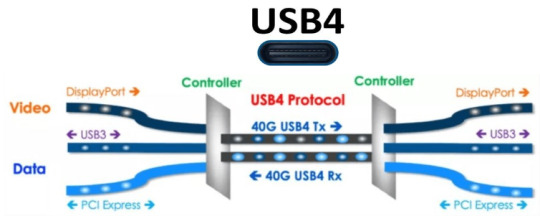
USB4 isUSB3.2 Subsequent versions of,It’s the latest USB specification。USB4 is the communication protocol,The hardware interface used is USB Type-C interface,USB Type-C Port based on USB3.x and USB4 Protocol transmission data。Its interface standard is composed of USB Promoter Group Developed,Mainly standardizedUSB4 Electrical characteristics of the interface、mechanical properties、Protocol specifications and other contents。Here are the following USB4 Some main characteristics:
Ø Data transmission speed:USB4 Interface support up to 40Gbps Data transmission speed,yes USB3.2 Twice the size of the interface。
Ø Power supply capacity:USB4 The maximum power supply capacity of the interface can reach 100W,Can meet the power supply needs of high-performance devices。
Ø Interface type:USB4 The interface adopts USB Type-C interface,Can be plugged in and out in both directions,Easy to use。
Ø compatibility:USB4 Interface backward compatibility USB3.2、USB2.0 and USB1.1 equipment,Compatible with multiple devices。
Ø Protocol support:USB4 The interface supports multiple data transmission protocols,include USB3.2、Thunderbolt 3、Display Port etc.。
Ø video transmission :USB4 Interface support up to 8K Video transmission,Can meet the needs of high-resolution video transmission。
Overall,USB4 A very advanced USB specification,It provides users with faster data transfer speed、Higher power supply capacity and wider compatibility。
But this kind of USB4 hardware interface USB Type-C Often subjected to electrostatic discharge (ESD)/EOS The impact of the event,Why?
two、 USB4 hardware interface USB Type-C suffer ESD/EOS reason
Ø USB Type-C The interface is relatively compact,And the distance between its metal contacts is relatively small,This makes them more susceptible to the effects of electrostatic discharge。
Ø USB Type-C Interface is usually used to connect various electronic devices,These devices may generate different electrostatic discharges,Thereby affecting the normal operation of the interface。
Ø The human body is a common static power source,When we touch USB Type-C At interface time,May transfer static charges from the body to the interface,trigger ESD harm。
Ø Hot swapping Or charging,Failure to properly protect against surge can causeEOSEvent occurrence。
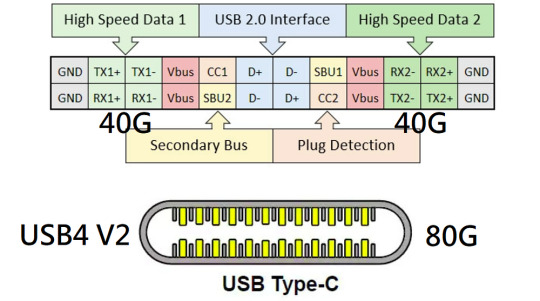
three、 USB4 What are the interface signals
USB4 interfaces(USB Type-C )There are a total of 24 pins in the standard,among(Tx1+、Tx1-、Rx1+、Rx1-)Four pins, two differential pairs,Form a channel,The other four pins(Tx2+、Tx2-、Rx2+ Rx2-)Form the second channel。Data is transmitted between two sets of four bidirectional pin pairs。This dual channel configuration operates on a per channel basis 20Gbps Transmission speed of data,When using two channels, the speed can reach 40Gbps。And because USB Type-C The small size of the plug and the tight arrangement of its pins,The pin configuration is shown in the above figure,So it is recommended to use small-sized separation ESD(TVS)Do protection,The following introduces each signal function in the interface one by one,And protection methods。
1. Super high speed TX+ ,TX- ,RX+, RX- Differential line
high speed Differential signal line,Supports up to 40Gbps Ultra high speed USB Interface and alternating mode data transmission,Resolution up to 8K (7680 x 4320),The refresh rate is 60Hz。Due to the interface attempting to maintain extremely high speed while transmitting large amounts of content,Therefore, choose the appropriate one ESD(TVS) Protective devices are crucial。Shanghai Leiditech recommends using low junction capacitor 0.2PF,Small volumeDFN0603 Convenient wiring,Bring it back for scanning,Low clamping voltageULC0321SPerform electrostatic protection,Ensure signal integrity。
2. D+/D- Differential line
For USB 2.0 interface,D+ and D- Pin data rate 480Mbps,The voltage on this differential line is normally 5V,Consider line speed and recommend using itULC0521C,Low junction capacitance 0.3PF , Small volumeDFN0603,Convenient wiring。
3. VBUS
VBUS:Power cord,Used for transmitting power supply。Consider using USB-PD Satisfy charging,Recommend using high-power ESD(TVS) SMDA24TNPerform electrostatic surge protection, Encapsulated asDFN1610–2 ,Peak current 30A,Power 1650W。
4. CC、SBU
CC1、CC2:Communication channel,Used to identify connected devices and determine power direction。
SBU1、SBU2:Auxiliary channel,Can be used to support high-speed data or other functions。
CC/ SBU Pins are tightly adjacent to each other VBUS Pin。apply USB-PD The words,VBUS The pin voltage can reach 20V,such,CC/SBU Pins are prone to short circuits up to 20V, To avoid damage,These two pins are recommended to be 24V ESD(TVS) Protecting:ULC2421。
Do a good job in protecting the above signals,USB4 Will be exempt from some electrostatic surge events。
four、 USB4 Interface electrostatic surge protection scheme
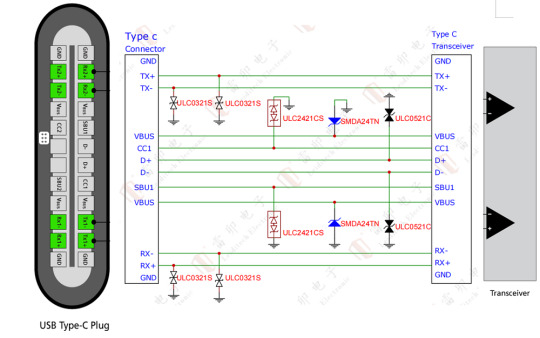
Leiditech Electronics is committed to becoming a leading brand in electromagnetic compatibility (EMC) solutions and component supply. We offer a wide range of products, including ESD, TVS, TSS, GDT, MOV, MOSFET, Zener diodes, and inductors. With an experienced R&D team, we provide personalized customization services to deliver the highest quality EMC solutions tailored to our customers’ needs.
If you’d like to learn more or have any questions, don’t hesitate to reach out:
Visit us at [en.leiditech.com]
🔗 #USB4 #TypeCProtection #ESDProtection #Leiditech #SurgeProtection #TechInnovation #ElectronicsDesign #EMCSolutions #HighSpeedData #PowerSafe #TVSDiodes #8KReady #NextGenUSB #CircuitProtection #USBPD #HardwareDesign
0 notes